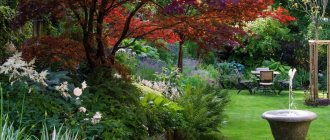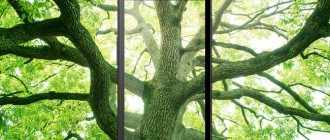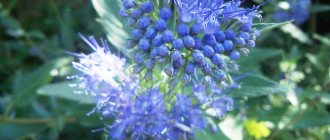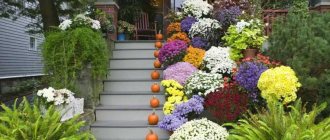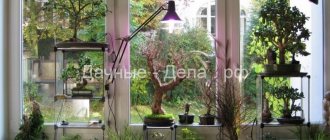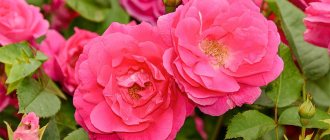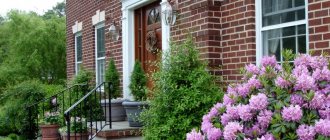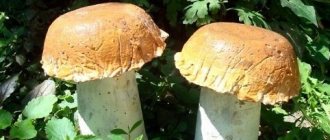- Lavender angustifolia
- Antennary
Evergreens are decorative all year round. First of all, these are conifers, which in summer effectively emphasize the beauty of the surrounding flowers, and in winter they solemnly turn green against the backdrop of white snow. But we decided to talk about deciduous trees, mainly of southern origin, which are also very popular in landscape design. We offer an overview of interesting types of evergreen plants for the garden with photos, names and brief descriptions, and ideas for creating compositions with their participation.
Experienced gardeners use topiaries to transform trees and shrubs into original topiaries
Evergreen perennials are represented by all life forms: trees, shrubs, subshrubs, shrubs, herbaceous plants.
Trees
Trees that remain decorative all year round are planted on the site both singly and in groups, create hedges, and become the main accent in a mixborder.
Yew berry
Yew berry belongs to the class Coniferous, the Yew family. It grows up to 20 m in height, although this will take more than one century. Unlike conifers, it does not have cones, but seeds surrounded by a fleshy, juicy red shell, similar to berries. That is why it is also called “mahogany”.
All parts of the plant, except the fruit shell, are poisonous!
Relict trees are common in the Caucasus and the Black Sea coast. Shrub forms are more often used in cultivation.
“Repandance” is a low-growing, shrubby yew, growing up to 50 cm. It is planted on alpine hills, in mixborders, along paths, around ponds
Interesting varieties with unusual colored needles. For example, “David” (bright lime), “Summergold”, “Cooper Gold” (yellow), “Elengatissima” (light green, cream). All of them are suitable for growing in the middle zone.
"Elengatissima" grows no more than half a meter, the intensity of the color of the needles depends on the light
Boxwood
Boxwood occurs in woody and shrub forms; about 30 varieties are known. Trees can grow up to 12-15 m. These are also ancient, relict plants, which in nature, together with yew, form large yew-boxwood groves. Boxwood has leathery, oblong leaves located oppositely on the stem. Small, inconspicuous flowers emit a strong aroma. The wood is very dense and heavy.
Decorative forms are traditionally used by designers to decorate the landscape
Variegated species are interesting, for example, evergreen boxwood “Variegata” (pictured).
An unpretentious, shade-tolerant shrub feels good in a pot, suitable for indoor keeping
Holly
Holly (holly) belongs to a genus of trees and shrubs of the Holly family, growing in temperate and tropical climates. In their natural environment, trees reach 10-20 m. Holly leaves are beautiful, shiny, carved, dark green or two-colored; may have thorns. The brightly colored berries (drupes) of red, orange, yellow, white or black often remain on the branches throughout the winter.
Holly is especially prized in Europe, where it is used to make wreaths to decorate homes at Christmas.
Holly is unpretentious in care, but loves fertile soils, responds to fertilization with abundant foliage and flowering, and responds well to formative pruning. When planting in the garden, hydrangea, mahonia, cypress, and euonymus will make good company for holly.
For growing in the country, it is more convenient to choose dwarf hybrids or spectacular variegated shrubs, for example, “Argentea Marginata”
Boxwood
Boxwood is a low-growing ornamental plant that is excellent for landscape work. With its help, you can form a hedge or border, or use it for zoning the garden. Loves sunny or slightly shaded areas, well-loose soil, and frequent, timely watering. It does not tolerate too shaded places or cold - in the fall its roots need to be covered with dry pine needles or sawdust.
Boxwood is a perennial plant that grows quickly and chaotically in height and requires periodic pruning. Can be quite effective with proper care.
At the same time, boxwood, although beautiful, is poisonous. It is best to care for it with gloves.
Ivy in garden decor
Watering evergreens
Shrubs
Most evergreen shrubs are not adapted to harsh winters and require shelter.
An overview of varieties suitable for cultivation in temperate climates is given in the table:
| Shrub name | Characteristic | Varieties |
| Euonymus Fortune | Like all types of euonymus, it is valued for the decorative coloring of its leaves. This is a creeping, creeping form. Widely used as a ground cover under trees and in rock gardens. Needs shelter in winters with little snow | Canadale Gold with yellow-edged leaves; Minimus – forms a low green carpet, ideal for alpine slides and rockeries; Blondy – green leaves with a large cream spot in the middle, grown as a vine, as a ground cover, in container culture |
| Common privet | A relative of lilac, it belongs to the Olive family. About 50 varieties are known, but only 2 varieties of common beetroot have successfully spread in central Russia. It is best suited for creating hedges. Propagates well from cuttings. Loves sunny places, drought-resistant | Aureum – 0.8-1 m high, has golden foliage, does not bloom; Atrovirens – leaves are dark green in summer, purple-brown in autumn, blooms with white panicles |
| cotoneaster | A non-thorny berry bush from the Rosaceae family. Notable for its dark foliage that turns red in autumn. The flowers are inconspicuous, white or pink. The berries are red or black. Cotoneaster hedges often decorate city streets | Among the most frost-resistant varieties: brilliant, whole-edged, black-fruited |
| Mahonia holly | Squat, up to 1 m, shrub of the Barberry family. The leaves are leathery, dry, with teeth. It blooms with bright yellow flowers, in place of which bluish berries are formed. By autumn the bush turns red. Mahonia is usually used to create groups and borders | Fruit varieties: “Slastena”, “Rusalka”, “Timoshka”. Decorative: "Smaragd" - with lush bright yellow inflorescences; "Dureya" - distinguished by yellow-green foliage; “Compact” – up to 50-70 cm high |
| Rhododendron | A beautifully flowering shrub of the Ericaceae family with varied colors of corymbose or panicle-shaped inflorescences. Prefers places protected from the wind and diffused light. Demanding on soil fertility, needs abundant watering | They tolerate winters well: Japanese, Daurian, Canadian, Katevbinsky |
Katevbinsky rhododendron, judging by the descriptions and reviews, is an unpretentious, frost-resistant crop
Many shrubs, as noted above, are excellent for forming hedges.
Privet grows quickly and forms a dense fence that needs regular trimming
Azalea japonica
When it comes to Azaleas, most people only remember small indoor flowers in pots on the windowsill.
But nature has created many species of this shrub. We are interested in Japanese Azalea, which is also sometimes called evergreen. In landscape design. During flowering (April - May), Azalea is covered with so many flowers that sometimes it is even impossible to see the bush itself. Due to its natural brightness, Azalea is often used in the center of compositions, for example, large flower beds. In addition, there are a huge number of varieties on the market in almost any color.
Care. Japanese azalea is one of the few evergreen plants that is extremely demanding to care for. To prevent this shrub from dying, it needs to be provided with a suitable location (usually partial shade is best), sufficient humidity, and shelter in winter.
Dwarf forms
Thanks to their compactness, beauty of flowering, and aroma, low shrubs, subshrubs and shrubs have earned the well-deserved respect of professionals and flower growers who want to make their garden unusual, modern, and stylish.
Lavender angustifolia
The essential oil crop from the Lamiaceae family is grown on an industrial scale, as well as in gardens around the world. Lavender propagates well by seeds. In regions with a mild climate, winter sowing is practiced.
Flower growers in the middle zone stratify the seeds for two months before planting on the bottom shelf of the refrigerator, and sow them for seedlings in February - March.
For lush flowering and maintenance of shape, annual pruning is carried out in the spring, shortening the shoots by a third
Ericaceae
Rock gardens and rocky gardens are often decorated with evergreen shrubs from the Heather family. If desired, you can create entire heather meadows from them, which will bloom from spring to autumn.
Common heather is available in a wide range of varieties (about 500), varying in height, foliage color and flower color.
Erica is a relative of heather, differing from it in the time of flowering, which begins in spring, and in its needle-shaped leaves. Heather blooms in late summer–autumn and has more scaly leaves.
White, pink, burgundy, blue, purple Erica “bells” retain their decorative effect for a long time after flowering
The lower tier of flower beds and alpine hills are a great place for common podbela . Its second name is andromeda. The plant is poisonous, so you need to work with it very carefully.
Pale pink, like porcelain jugs, drooping, white flowers are contrasted with dark bluish-green foliage
What are hard-leaved forests
Hardleaf forests are forests growing in a subtropical climate.
This climate is characterized by dry and hot summers, with an average air temperature of 20 to 25 ° C, and cold winters with heavy rainfall (about 600 mm per year). These forests make up 3% of all forests on the planet. Hard-leaved forests have a tiered structure. Due to lack of moisture in summer, plants have to adapt. Most of them have gray-green leaves, and some have completely changed their structure and become like thorns. All this is necessary in order not to waste water. Another characteristic feature of hard-leaved forest plants is the roots, which go very deep into the ground, thus obtaining water for life. And the plants themselves never shed their leaves, which is why they are also called evergreen forests.
There are several zones of hard-leaved forests on Earth, mostly along the shores of seas and oceans. And they are named so because of the dense and rigid structure of the leaves of the trees, which store valuable moisture in these places.
The main areas of forest growth are Australia, North and South America, southern Europe and eastern Asia.
Man also did not ignore these territories and developed them. Significant areas of forests have been cut down and in their place pastures, plots for farming have been built, or trees are simply used for domestic and construction purposes.
Ground covers
Perennial evergreen ground cover plants are not only permanent residents of rocky gardens, slopes and flower beds decorated with stones. They are planted in the foreground of ordinary flower beds, in some places they are used as a lawn, they decorate the trunk circles of fruit and ornamental trees, shrubs, and they are planted on poor, sandy soils. All of them are very unpretentious, have the ability to grow quickly and fill space. Forming a thick carpet or dense cushions, such plants give the landscape a forest flavor (periwinkle, tenacious) or imitate the atmosphere inherent in mountain landscapes (antennaria, bryozoan). In addition, they help curb the growth of weeds.
Antennary
It is very attractive due to the felt, silvery pubescence of the foliage, soft, pretty inflorescences, thanks to which it received the popular name “cat’s paw”. Belongs to the Asteraceae (Asteraceae) family. In nature it grows in mountainous areas and pine forests.
Three varieties of Antennaria are grown in culture: alpine, dioecious (pictured) and plantain-leaved
Periwinkle
An amazingly viable plant from the Kutrovaceae family. Due to the high content of alkaloids, it is poisonous, but, nevertheless, it is highly valued by gardeners for its unpretentiousness, shade tolerance, the beauty of the dark green carpet it produces and its rather large, often blue, flowers.
Currently, varieties of small periwinkle have been bred with white, pink, red corolla colors, terry, with variegated leaves
Creeping tenacious
Creeping tenacious (auyuga) from the Lamiaceae family attracts attention not only with the beauty of the inflorescences, but also with the decorativeness of the leaves, which is also influenced by the degree of illumination. Greenish-cream, burgundy, pinkish, purple-violet, with spots and stains... The tenacious plant is often planted in flower beds, alpine hills, where it fills well the voids between stones, along paths.
Tenacious is great for decorating shady places, for example, near the wall of a house or under trees, in combination with hosta, astilbe, spirea
Bryozoan awl-shaped
Miniature grass, up to 8 cm high, from the Clove family. From the end of spring it is covered with small snow-white flowers, which continue to appear until autumn. Forms dense pillows. It is placed in rocky gardens, used as an element of borders, and as a lawn covering.
The second name is Irish moss; the bryozoan received its external similarity to mosses. The homeland of the plant is Scandinavia and Eastern Europe
Use Cases
Evergreen plants for the garden can be used in the design of the site in a variety of ways.
Landings
The simplest option is to plant plants so that they shade different corners of the garden. If you combine different heights and different shades of foliage, even in winter there will be some diversity in the area.
Hedge
If you make it from deciduous plants shedding their leaves, in winter it will lose all meaning and turn into an interweaving of dull black branches, through which you can clearly see what is happening on the site. If you use evergreens for a hedge, even in winter it will retain its impenetrability and chic appearance.
Garden decor with evergreens
Living sculptures
Made from plants that shed their leaves, the sculptures become quite unsightly in winter. Made from evergreens, they will retain their shape and chic even under the snow.
Curbs
Zoning an area is one of the best functions of low-growing shrubs. They can be used to separate plantings from paths, paths from lawns and lawns from the house. In addition to the aesthetic function, they can also perform a protective function: do not allow the wind to pass through, do not allow weeds or grass to grow from the lawn.
Decorating fences, gazebos and any trellises
For this purpose, evergreen climbing plants are best suited, which will allow you to make your house or gazebo look like castles covered with ivy in winter.
Spruce in the garden
Depending on the purpose, you need to choose suitable plants - each of them is good for achieving certain goals.
Aubrietta
Perhaps one of the most colorful and picturesque plants in the garden is the aubrietta. It is often used to create vertical gardening or flower beds. Representing an evergreen carpet, aubrietta will color your area in lilac and purple tones. Spectacular velvet flowers will decorate the slope, go down the wall, and cover the rocky hill.
This plant loves loose, moist soils with good drainage. For long and abundant flowering, plant the obrietta in a sunny place and provide timely watering, weeding and loosening.
Animals of hardwood forests
Due to climatic conditions, animals of hard-leaved forests lead an active lifestyle in autumn and spring. These periods are the most favorable. The inhabitants of these latitudes seem to have mixed; here you can meet both representatives of the temperate zone and tropical inhabitants.
Mammals, birds, reptiles, predators, rodents, insects - you name it! Let's look at the most prominent representatives of this natural area.
The European mouflon is a representative of mammals. Outwardly, this animal looks like a ram. The large, curled horns definitely set the mouflon apart from the rest. They live on mountain slopes.
The Mediterranean tortoise is endowed with a powerful shell of a convex shape. The turtle hides its head in its shell in case of danger. The animal is very slow.
The blue magpie is the most beautiful bird in Europe. The color of the bird is varied and interesting. It itself is small in size, about 35 cm. It uses berries, seeds and small insects for food.
The skink gecko is a beautiful lizard with a bright color and a body covered with scales. This animal is nocturnal. Hunts insects. The peculiarity of these lizards is that each has its own territory for hunting and does not enter someone else’s. When in danger, it drops its tail and soon grows a new one.
Marsupial bear and koala. They are found in the forests of Australia, where eucalyptus trees grow. Animals are small in size and lead a large lifestyle.
The leopard is a member of the cat family. This predator is very beautiful. Leopards live in Africa and Asia. They prefer to live in thickets.
The European genet is a small animal that looks like a cat. It feeds on small rodents and birds. The main feature of the genet is its thick coat, which helps to survive severe frosts.
As you may have noticed, the fauna of the evergreen kingdom is replete with a variety of species that form a complete ecosystem.
Features of hard-leaved forests
We will not go into details again of the climatic conditions of the hard-leaved forest zone. Let's talk about vegetation.
The main characteristic feature of evergreen plants is their ability to survive the dry and hot summer season. The peculiarities of the soil and climate force the fauna of this zone to adapt to its complex “character”.
The Mediterranean region is home to plants with interesting “functions” – aroma. During evaporation, they release certain aromatic substances that can lower their temperature and attract insects for pollination.
The main part here is made up of coniferous trees. The huge variety of coniferous trees is not found anywhere else. The mixture of different types of flora changes from north to south and from west to east.
Hard-leaved trees have their leaves arranged in such a way that they look into the ground at a certain angle. This is necessary so that sunlight reaches the roots. Their leaves are hard and smooth, they store moisture, which is needed during the dry season. And trees equipped with simpler needles can simply shed their needles at unfavorable times of the year.
Heather
Heather is an evergreen plant with a branching stem base. The leaves are small, triangular, and there is no petiole. Small flowers are grouped into racemose or umbrella-shaped inflorescences. One inflorescence can contain from five to several dozen flowers that have a lilac-pink hue.
Heather does not require frequent care, is drought-resistant and can bloom in the shade. Throughout the winter, the leaves remain green.
Plants of hard-leaved forests
Evergreen hard-leaved forests have layers, in this they are no different from most other forests. What is their peculiarity? As we said earlier, a characteristic feature of these forests is their special vegetation. The trees are very tall with deep roots and hard leaves. Not all plants here have hard and large leaves; some, on the contrary, are small-leaved or have needles.
The dominant plant here is the cork oak. They can reach a height of 20 meters. Due to climatic conditions, some shrubs and low trees have changed, they received the common name - maquis. This vegetation does not exceed 4 meters in height. Maquis has dense vegetation, and in some places even thorny species can be found.
Another concept is gariga. This is also a modified form of low trees, about 1.5 meters high. Thyme, rosemary, kermes oak are all representatives of garrigue. They are found mainly in dry or fire-damaged areas. Gariga appears where maquis formations disappear for various reasons.
Freegana is a vegetation cover of sandy or rocky soil. Cereals, perennial herbs, shrubs and the absence of trees are its characteristic features.
Shibljak is a combination of evergreen and deciduous plants. The vegetation includes lilac, rose hips, hawthorn, blackthorn, and hornbeam.
Scrapers - eucalyptus trees and thickets of thorny bushes. They appear in areas that are almost dry, where there are no rivers.
Separately, it is necessary to highlight the eucalyptus forests located in Asia and Australia. Among them you can find simply gigantic trees, over 100 meters high, and with roots going as much as 30 meters underground! But there are also low-growing eucalyptus trees and even shrubs. There are 525 species of eucalyptus trees in Australia.
Ecological problems of hard-leaved forests
Previously, the plants of hard-leaved forests were different, but due to human activity they have changed. Centuries of soil change, erosion, and leaching of biological substances lead to the appearance of barren areas and the disappearance of forests. All this leads to the appearance of rocky soils that are unsuitable for plants. And where there are no plants, animals disappear.
The main dominant plants of the evergreen forest were holm and cork oak. Dense oak thickets are now almost eliminated. Here, in their place, people built holiday homes, sanatoriums, and vineyards. And valuable oak species were cut down and used for production purposes.
But this is not all the problems the forest faces. In addition to intensive deforestation, forests suffer greatly from fires. This is a common occurrence during dry periods in summer. Huge territories are disappearing literally before our eyes.
And fertile brown soils attract people even more. When moistened, they become even more fertile. Therefore, most of the territories are developed for agriculture.
Where is the hard-leaved forest zone located?
Evergreen forests are located along the coasts of Africa, Australia, western North America and the Mediterranean Sea. This arrangement is not without reason. The lack of moisture in the summer in the interior of the continents is the main reason for this.
All forests, although they have the same name, are different in their vegetation. For example, in Australia, shrubs are common, and the forest itself is light and quite sparse. The Mediterranean, Africa, Chile, California, on the contrary, are enriched with dense tracts of hard-leaved trees and a deep root system. On the northern part, the neighbors are forests of temperate latitudes, and on the south there are tropics, deserts and savannas. Such proximity determines the animals of evergreen forests. It’s like there’s a symbiosis of all the adjacent territories.
But monsoon rainforests (yes, there is such a thing) are typical for the eastern districts. For example, Eastern China, Southeastern USA and Southern Brazil. The abundance of precipitation affects vegetation. The bulk of mixed evergreen forests are concentrated here. A special feature of these areas is the presence of tall trees.
Cypress
Evergreens, a list of which is presented in this article, are very often used to create decorative hedges. Trees reaching a height of 1 to 25 meters are also suitable for these purposes. They have a round or cylindrical crown, and in the second year of life, beautiful cones ripen, shaped like flower buds. Currently, there are at least 100 species of cypress trees. These plants have soft needles that do not prick when in contact with human skin. The needles can be colored light green, blue or green. Trees look like tall columns. The branches on them are located symmetrically.
Cypress trees are wonderful evergreens for the garden, but they do not like shade. Their needles fall off when there is a lack of sunlight. Cypress trees are unpretentious. They are not picky about soil and can withstand dry periods. If the drought lasts for a long time, then the plant is watered. Cypress does not tolerate frost, so it should not be planted in the northern regions of the country.
Overgrown branches should be pruned annually in August, as they grow very quickly. If the cypress is planted in infertile soil, then three-component fertilizers should be applied once a year. Trees propagate by cuttings.
Mahonia holly
A foyer of glossy dark green holly-like leaves is highlighted by clusters of golden-yellow bell-shaped flowers in the spring and blue berries in the fall.
Flowers/fruits
The flowers are yellow, in multi-flowered racemes, fragrant; the fruits are blue-black.
Does not require pruning.
Note
Mahonia tolerates shade well and can even grow under trees and shrubs.
Pine
Pines have a dense crown, which begins to thin out over time. The trunk of the tree is long, the bark is rich brown. These evergreens respond well to pruning. The crown is shaped in the summer, until the movement of sap stops. In the spring, pinching is carried out. This is necessary for the side shoots to grow. Pines are very vulnerable. They can be attacked by aphids, scale insects, and bark beetles. They are fought using special means. Hard-leaved evergreens, such as pine trees, are not used for making hedges, as they can thin out, which will deteriorate the entire composition.
Common juniper
This plant with bluish-gray or bluish-green needles fits perfectly into natural gardens, for example, together with heather. It grows very slowly and can look like a narrow column, spherical or flattened bush.
Flowers/cones
Male earrings are yellow, female cones are light green; In autumn, fleshy, blue-black cones appear. They ripen in 2-3 years and look like berries (cone-berries).
This beautiful evergreen plant causes virtually no trouble - it does not need pruning, sometimes it only requires support.
Note
Particularly decorative are varieties with a columnar crown, which are in no way inferior in decorativeness to trees after topiary.
Hardleaf forests of Eurasia
The evergreen forest zone covers the Mediterranean coast, and more precisely, southern Europe and eastern Asia. Dry, very hot summers and rainy, cold winters are the eternal companions of the subtropical forests of Eurasia.
Brown soils, characterized by a high humus content, are very fertile.
Plants with a special structure of rather hard and shiny leaves. This structure helps to stock up and not lose moisture in the summer heat.
Maquis is the predominant vegetation type here. These plants are adapted to drought, mainly shrubs and thorns. There are practically no forests.
Plants here include pine, cork oak, cypress, laurel, and citrus trees. And the most striking representatives are the shrub and kermes oak. In mountainous areas there is already a different vegetation that replaces shrubs. And at an altitude of over 800 meters there are broad-leaved and coniferous forests.
Animals of this region are turtles, lizards, snakes. There are predators (for example, a jackal), monkeys (a tailless macaque macaque).
Periwinkle
This is a perennial herbaceous plant that can lift everyone's spirits. The effect is achieved thanks to beautiful colors of pink, purple and other shades. The subshrub grows up to 70 cm in height. Its leaves are dense, shiny and pleasant to look at.
Lesser Periwinkle is also unpretentious in care. But he prefers more shaded space. The plant remains green at any time of the year, even in a very unstable climate it will delight others with its beauty.
Mountain pine
Mountain pine goes well with heather, but also looks good in rocky gardens. It is also suitable for growing in containers.
Flowers/cones
Male cones are greenish, female cones are reddish; cones are ovoid, young black-brown, mature yellowish-brown.
Pruning is not necessary, but growth can be curbed by breaking off the tops of the shoots once a year.
Note
Varieties vary greatly in height. Pay attention to this when purchasing.
Rejuvenated
This is a perennial from the Crassulaceae family. Succulent shoots and leaves distinguish the young plant from the variety of other plants and give it a charming appearance. Juvenile is often called a “stone rose”, since to gardeners it resembles a bud growing straight from the ground. Only the petals of the “rose” are green and incredibly fleshy.
In cultivation, juveniles have established themselves as a very unpretentious plant. It grows well even on dry sandy soils, but for better development it is worth planting it on humus-rich light loams. Juveniles are drought-resistant, love the sun and absolutely do not need watering.
Holly Meserve
Green shiny leaves with deep red petioles and shiny dark red fruits are typical for different varieties of this shrub.
Holly leaves and fruits are poisonous!
Flowers/fruits
The flowers are white, inconspicuous; red berry-like drupes.
Suitable for curly haircuts.
Note
Plant for mild climates. In central Russia, compact varieties can be grown in containers.
Mahonia holly
This decorative evergreen shrub is not only attractive, but also useful. Its dark blue berries can hang on the bush and please the eye for about 5 months, while their taste properties will remain the same. The berries of this plant are considered dessert; they taste quite pleasant.
Mahonia leaves are also not inferior in beauty to the berries. The green leaves, carved at the edges, turn purple in winter, but this only increases their attractiveness.
Mahonia holly loves both shade and light. It does not tolerate stagnant water, so water only in dry weather.
In winter, young Mahonia will not always be able to survive, so to help it, cover the bush in the first years of life before frost with spruce branches. Then this plant will serve your garden as a decoration for many years.
